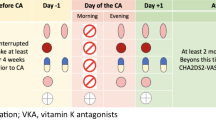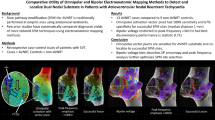Abstract
Objectives
Persistent atrial fibrillation (AF) causes atrial remodeling, which causes myocardial fibrosis and micro-reentry. Fibrosis may reduce wave voltage and micro-reentry may enhance the dominant frequency (DF) of the F-wave. We investigated whether the DF predicts procedural success by the Maze procedure.
Methods
In 138 consecutive patients who underwent mitral valve surgery and a modified Cox-Maze III procedure for persistent AF in Nagoya University in 2002–2018, 96 (70%) were successfully cardioverted (group S); 42 had persistent or relapsed AF after surgery (group F). Patient data were compared between the groups. Cut-off values were determined by an ROC analysis and predictors of procedural success were evaluated. The DF was obtained from the F-wave of V1 by a high-speed Fourier analysis using the CEPAS software program.
Results
Group F showed a significantly larger LA diameter, better LVEF, lower F-wave voltage, higher DF, and longer duration of AF. The cut-off values were as follows: LA diameter, 56 mm; EF, 64.5%; F-wave voltage, 0.13 mV; DF, 7.3 Hz; and duration of AF, 44 months. Each factor showed statistical significance in a univariate analysis; DF lost significance in the multivariate analysis. The higher (DF ≥ 7.3 Hz) and lower voltage group (≤ 0.13 mV) showed the worst procedural success rate (36%), while the lower DF (< 7.3 Hz) and higher voltage group (> 0.13 mV) showed a good rate (86%).
Conclusions
The DF of the F-wave is a useful predictor of procedural success after the Maze procedure in addition to the voltage of F-wave.


Similar content being viewed by others
Abbreviations
- AF:
-
Atrial fibrillation
- DF:
-
Dominant frequency
- LA:
-
Left atrial
- LVEF:
-
Left ventricular ejection fraction
- ECG:
-
Electrocardiogram
- FFT:
-
Fast Fourier transform
References
Cox JL, Schuessler RB, D’Agostino HJ Jr, Stone CM, Chang BC, Cain ME, et al. The surgical treatment of atrial fibrillation. III. Development of a definitive surgical procedure. J Thorac Cardiovasc Surg. 1991;101:569–83.
MacGregor RM, Khiabiani AJ, Bakir NH, Manghelli JL, Sinn LA, Carter DI, et al. Impact of age on atrial fibrillation recurrence following surgical ablation. J Thorac Cardiovasc Surg. 2021;162(5):1516–28.
Ad N, Holmes SD, Shuman DJ, Pritchard G. Impact of atrial fibrillation duration on the success of first-time concomitant Cox maze procedures. Ann Thorac Surg. 2015;100:1613–8.
Sunderland N, Maruthappu M, Nagendran M. What size of left atrium significantly impairs the success of maze surgery for atrial fibrillation? Interact CardioVasc Thorac Surg. 2011;13:332–8.
Kakuta T, Fukushima S, Shimahara Y, Yamasaki T, Matsumoto Y, Yamashita K, et al. Contemporary outcomes of the concomitant CryoMaze procedure. Interact Cardiovasc Thorac Surg. 2019;29:28–34.
Kazui T, Henn MC, Watanabe Y, Kovács SJ, Lawrance CP, Greenberg JW, et al. The impact of 6 weeks of atrial fibrillation on left atrial and ventricular structure and function. J Thorac Cardiovasc Surg. 2015;150:1602-8.e1.
Nault I, Lellouche N, Matsuo S, Knecht S, Wright M, Lim KT, et al. Clinical value of fibrillatory wave amplitude on surface ECG in patients with persistent atrial fibrillation. J Interv Card Electrophysiol. 2009;26:11–9.
Yamamoto S, Suwa M, Ito T, Murakami S, Umeda T, Tokaji Y, et al. Comparison of frequency of thromboembolic events and echocardiographic findings in patients with chronic nonvalvular atrial fibrillation and coarse versus fine electrocardiographic fibrillatory waves. Am J Cardiol. 2005;96:408–11.
Lo LW, Tai CT, Lin YJ, Chang SL, Udyavar AR, Hu YF, et al. Predicting factors for atrial fibrillation acute termination during catheter ablation procedures: implications for catheter ablation. Heart Rhythm. 2009;6(3):311–8.
Murase Y, Inden Y, Shibata R, Yanagisawa S, Fujii A, Ando M, et al. The impact of the dominant frequency of body surface electrocardiography in patients with persistent atrial fibrillation. Heart Vessels. 2020;35:967–76.
Sanders P, Berenfeld O, Hocini M, Jaïs P, Vaidyanathan R, Hsu LF, et al. Spectral analysis identifies sites of high-frequency activity maintaining atrial fibrillation in humans. Circulation. 2005;112(6):789–97.
Nogami A, Kurita T, Abe H, Ando K, Ishikawa T, Imai K, et al. JCS/JHRS 2019 guideline on non-pharmacotherapy of cardiac arrhythmias. Circ J. 2021;85:1104–244.
Cox JL, Jaquiss RI, Schuessler RB, Boineau IP. Modification of the maze procedure for atrial flutter and atrial fibrillation. II. Surgical technique of the maze III procedure. J Thorac Cardiovasc Surg. 1995;110:485–95.
Bollmann A, Husser D, Mainardi L, Lombardi F, Langley P, Murray A, et al. Analysis of surface electrocardiograms in atrial fibrillation: techniques, research, and clinical applications. Europace. 2006;8(11):911–26.
Husser D, Stridh M, Sornmo L, Olsson SB, Bollmann A. Frequency analysis of atrial fibrillation from the surface electrocardiogram. Indian Pacing Electrophysiol J. 2004;4(3):122–36.
Goette A, Honeycutt C, Langberg JJ. Electrical remodeling in atrial fibrillation. Time course and mechanisms. Circulation. 1996;94(11):2968–74.
Li D, Fareh S, Leung TK, Nattel S. Promotion of atrial fibrillation by heart failure in dogs: atrial remodeling of a different sort. Circulation. 1999;100(1):87–95.
Wijffels MC, Kirchhof CJ, Dorland R, Allessie MA. Atrial fibrillation begets atrial fibrillation. A study in awake chronically instrumented goats. Circulation. 1995;92(7):1954–68.
Ng J, Kadish AH, Goldberger JJ. Effect of electrogram characteristics on the relationship of dominant frequency to atrial activation rate in atrial fibrillation. Heart Rhythm. 2006;3(11):1295–305.
Bollmann A, Sonne K, Esperer HD, Toepffer I, Langberg JJ, Klein HU. Non-invasive assessment of fibrillatory activity in patients with paroxysmal and persistent atrial fibrillation using the Holter ECG. Cardiovasc Res. 1999;44:60–6.
Lazar S, Dixit S, Marchlinski FE, Callans DJ, Gerstenfeld EP. Presence of left-to-right atrial frequency gradient in paroxysmal but not persistent atrial fibrillation in humans. Circulation. 2004;110(20):3181–6.
Badhwar V, Rankin JS, Ad N, Grau-Sepulveda M, Damiano RJ, Gillinov AM, et al. Surgical ablation of atrial fibrillation in the United States: trends and propensity matched outcomes. Ann Thorac Surg. 2017;104:493–500.
Ad N, Damiano RJ, Badhwar V, Calkins H, La Meir M, Nitta T, et al. Expert consensus guidelines: examining surgical ablation for atrial fibrillation. J Thorac Cardiovasc Surg. 2017;153:1330-1354.e1.
Romero I, Fleck E, Kriatselis C. Frequency analysis of atrial fibrillation surface and intracardiac electrograms during pulmonary vein isolation. Europace. 2011;13:1340–5.
Funding
This research received no specific grant from any funding agency in the public, commercial, or not-for-profit sectors.
Author information
Authors and Affiliations
Corresponding author
Ethics declarations
Conflict of interest
None declared.
Additional information
Publisher's Note
Springer Nature remains neutral with regard to jurisdictional claims in published maps and institutional affiliations.
Rights and permissions
About this article
Cite this article
Usui, R., Mutsuga, M., Narita, Y. et al. Higher F-wave frequency associates with poor procedural success rate after Maze procedure. Gen Thorac Cardiovasc Surg 70, 997–1004 (2022). https://doi.org/10.1007/s11748-022-01836-0
Received:
Accepted:
Published:
Issue Date:
DOI: https://doi.org/10.1007/s11748-022-01836-0




